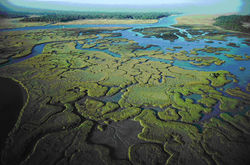Difference between revisions of "Template:This weeks featured article"
m (→Sampling tools for the marine environment) |
(→Spatial Planning and Integrated Coastal Zone Management) |
||
| Line 1: | Line 1: | ||
| − | == | + | ==Spatial Planning and Integrated Coastal Zone Management== |
| − | [[Image: | + | [[Image:estuary.jpg|thumb|250px|right|Coastal Ecosystems]] |
| − | + | Coastal and marine environments are usually characterized by beautiful landscapes and rich ecosystems of great importance, offering elements such as rich biodiversity. They also attract human activities such as tourism and industrial uses. However, the co-existence of human activities and natural resources often creates conflicts of use in the coastal zone. | |
| − | + | Management policies are an important means of implementing planning in order to minimise, prevent or resolve use conflicts. The development of a coastal and marine spatial planning system presents an opportunity for the implementation of an overall strategy of conservation, sustainability and management to maximise future economic profit. | |
| − | |||
| − | |||
| − | |||
| − | |||
| − | + | ||
| + | This article briefly discusses spatial planning, integrated coastal zone management (ICZM) and a comparison between the two. | ||
Revision as of 10:04, 25 August 2008
Spatial Planning and Integrated Coastal Zone Management
Coastal and marine environments are usually characterized by beautiful landscapes and rich ecosystems of great importance, offering elements such as rich biodiversity. They also attract human activities such as tourism and industrial uses. However, the co-existence of human activities and natural resources often creates conflicts of use in the coastal zone.
Management policies are an important means of implementing planning in order to minimise, prevent or resolve use conflicts. The development of a coastal and marine spatial planning system presents an opportunity for the implementation of an overall strategy of conservation, sustainability and management to maximise future economic profit.
This article briefly discusses spatial planning, integrated coastal zone management (ICZM) and a comparison between the two.
